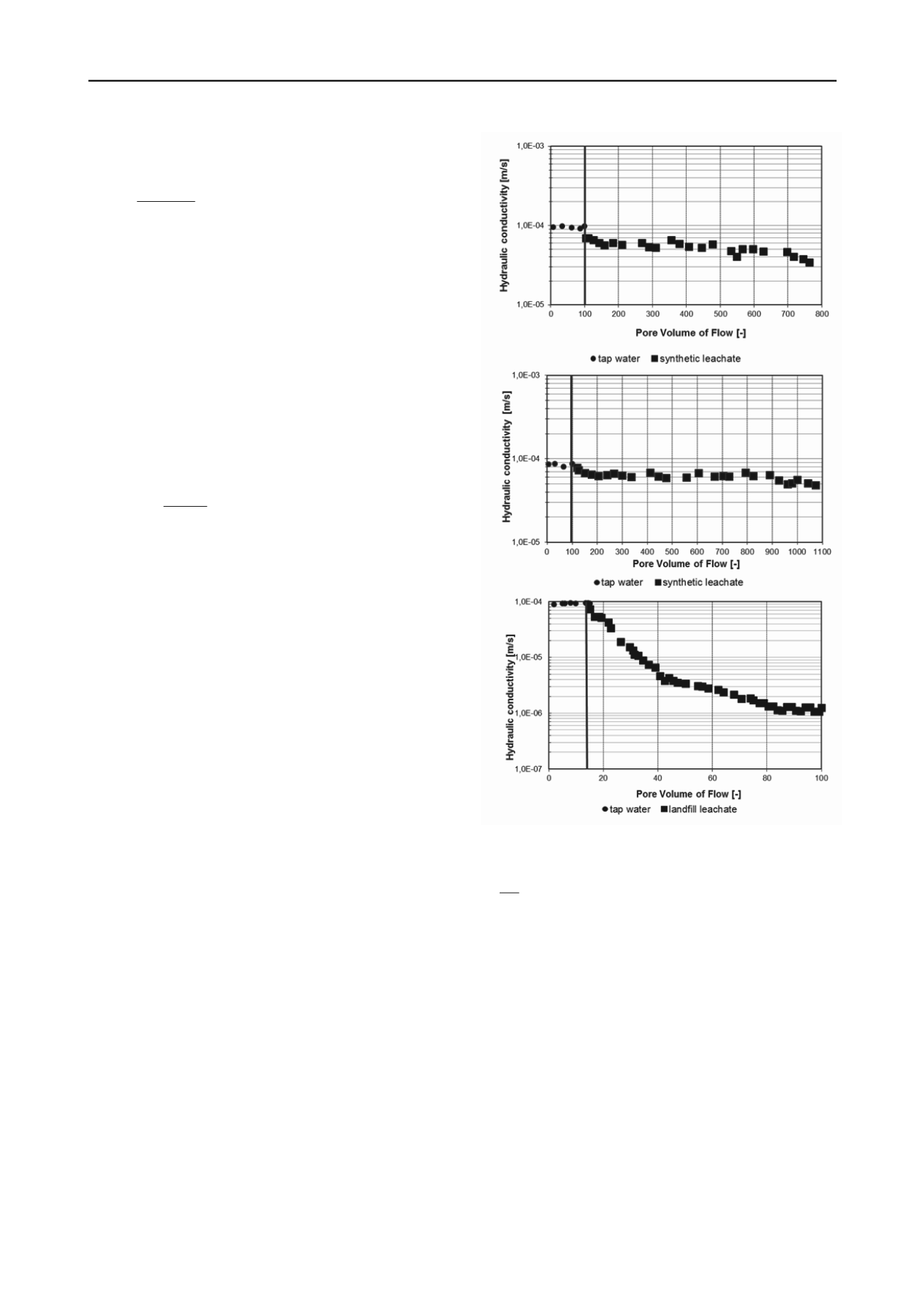
3023
Technical Committee 215 /
Comité technique 215
The hydraulic conductivity was calculated using equation
(ASTM D 5084 - 00):
a
c
b
t Ai
V k
(3)
where:
k – hydraulic conductivity (m/s),
V – volume of effluent (m
3
),
i – hydraulic gradient,
A – area of the specimen (m
2
),
t – permeation time period (s).
2 RESULTS AND DISCUSSION
The hydraulic conductivity tests were performed with distilled
and tap water, synthetic and landfill leachate. The results
obtained are presented in Fig. 4. The hydraulic conductivity
of samples is presented in relation to pore volume of flow,
which may be calculated using equation:
Ln
t ik
PVF
e
(4)
where:
PVF – pore volume of flow,
k – hydraulic conductivity (m/s),
i – hydraulic gradient,
t – elapsed time (s),
n
e
– effective porosity,
L – length of the sample (m).
The hydraulic conductivity of materials tested using tap
water was 9.8 E-5 m/s and 8.7E-5 of ZS50 and ZS20,
respectively. The hydraulic conductivity slightly decrees with
time at the beginning of the permeation with synthetic leachates
but stabilized after 100 pore volume of flow. After 800 pore
volume of flow hydraulic conductivity of ZS50 was 3.4E-5m/s
and of ZS20 6.8E-5 m/s. This represented about a 2.90- and
1.30-fold decrees as compared with the results of hydraulic
conductivity to tap water. The test results indicated
that the permeation synthetic leachate influence negligible
the hydraulic conductivity of zeolite-sand mixtures.
Franciska and Glatstein (2010) observed the similar relation
for compacted soil liners permeated with landfill leachate.
Results of study with landfill leachate indicated that hydraulic
conductivity of ZS50 have changed almost by two orders
of magnitude (from 9.23E-5 to 1.24E-6 m/s). Observed
permeability changes can be caused through inorganic
compounds precipitation, mainly CaCO
3
, and bioactivity
(VanGulck and Rowe 2004, Asadi et al. 2011). The analysis
of the calcium carbonate content using Scheibler method
showed no significant increase of carbonates in the samples,
while research in scanning electron microscope showed
increased calcium content and crystals of calcium carbonate
in the sample. Achieved results allow to conclude,
that permeability changes of zeolie-sand mixtures may
influence the operation conditions of PRB.
3 DESIGN CONSIDERATION
Considering the test results obtained the hydraulic criterion in
the evaluation of reactive materials such as zeolites and zeolite-
sand mixtures should be expressed as follows:
the ratio of hydraulic conductivity of the reactive material (k
s
)
to the hydraulic conductivity of the aquifer (k
g
)
Figure 4. Hydraulic conductivity of ZS50 (a) and ZS20 (b) to tap water
and synthetic leachate and ZS50 to landfill leachate (c).
10
g
s
k
k
(5)
Criterion (5) results from the necessity of taking into account
changes of the hydraulic properties of materials during PRB
exploitation. Laboratory studies showed a decrease of hydraulic
conductivity values of zeolite and zeolite-sand mixtures under
the influence of landfill leachate. In the case of zeolite-sand
mixtures with a zeolite content Z (dimensionless value),
estimation of hydraulic conductivity k
s
in m/s at relative density
I
D
requires the application of the following equation (Fronczyk
2008):
328 .0
D
s
IZA k
(6)
For mixtures made of zeolite with particle size of 1.0–2.5
mm, A = 3.0 · 10-4, whereas at particle size of 0.5–1.0 mm, A =
2.6 · 10-5.


